Internet of Vehicles (IoV)-Based Task Scheduling Approach Using Fuzzy Logic Technique in Fog Computing Enables Vehicular Ad Hoc Network (VANET)
Abstract
:1. Introduction
1.1. Fog Computing
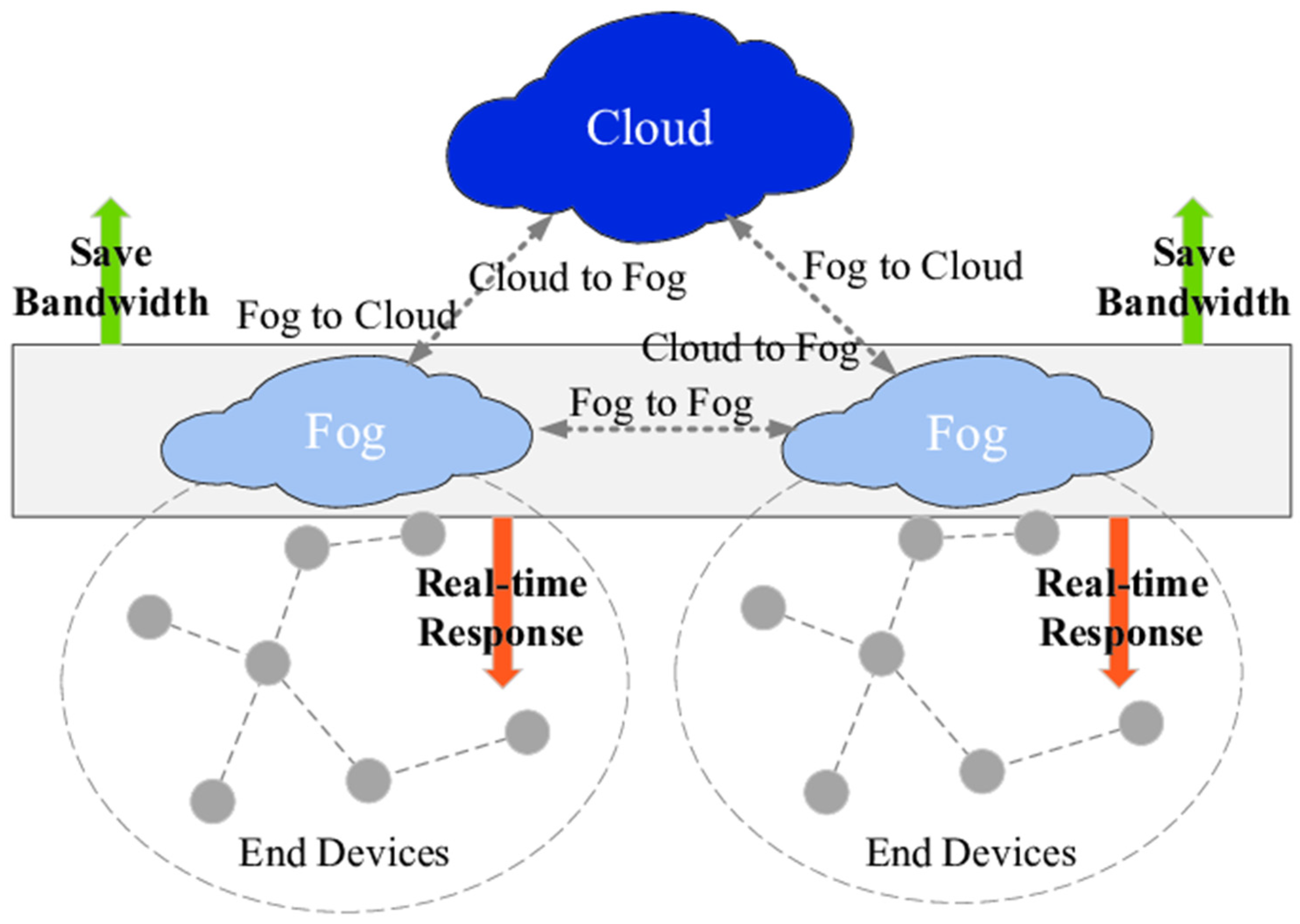
1.2. VANET and Its Architecture
1.3. Fuzzy Logic-Based Approach in VANET
1.4. Motivation
1.5. Importance of This Research
1.6. Problem Description
- (i)
- How does fog enhance the task processing capabilities of VANET vehicular tasks?
- (ii)
- How does one schedule the tasks through fog computing to save time and energy consumption from one node to another?
- (iii)
- How does fuzzy logic enhance task scheduling using fog computing?
1.7. Research Contributions
- In our proposed technique, we proposed a fuzzy logic-based fog-enabled task scheduling technique to enhance the task time and energy consumption efficiency in VANET.
- This research provides that fog enables fuzzy logic-based task scheduling that minimizes the delay rate in task processing and migration to fog VMs.
- The proposed technique uses vehicle nodes connected with VANET architecture consisting of fog and fuzzy logic fuzzification methods to offload the resource-intensive tasks to the fog layer through the scheduler and classifier.
- The proposed model was evaluated using the Mumdani fuzzification method to utilize the fuzzy logic under the supervision of the classifier to overcome the response time and service delivery time in the VANET environment.
- We designed a V2V-based fuzzy logic-based VANET architecture in which the vehicles are directly connected with a fuzzy classifier to overcome the energy consumption and response time for tasks produced in VANET.
- The proposed algorithms selected the tasks from the environment based on their features and matched them with the threshold. They passed them toward the fuzzy logic engine to be decided under the supervision of the fuzzy logic-based system.
- The proposed technique effectively schedules all the tasks through fog-enabled VANET.
- By contrasting it with current methods, the simulation experiments demonstrate the effectiveness of the suggested task scheduling framework. According to the findings, the suggested system performs admirably in terms of task ratio, typical turnaround time, makespan time, and average latency within the constraints of the network.
2. Literature Review
- Multiple decision algorithms have been proposed in the literature for fog-based task scheduling, considering parameters like task deadline, execution, security, CPU time, and processing.
- Infrastructure-assisted job scheduling using RSU-based volunteer computing has been suggested to utilize surplus resources and enhance the overall system performance.
- The transmission offloading technique (DTS-BPCT) is proposed to distribute contents in VANET, considering relay nodes for data transfer and computational layers at the fog for processing.
- Various heuristic-based task scheduling algorithms, including deadline-based and hybrid scheduling, have been proposed to balance cost and makespan time parameters in fog computing.
- Fuzzy logic-based task scheduling algorithms have been explored to handle the dynamic nature of tasks in VANETs, considering factors like delay tolerance and availability of tasks.
- The literature emphasizes the significance of fog-enabled task scheduling in handling energy constraints, communication costs, and processing power for efficient task processing in VANETs.
3. Methodology
- Initially, we set up the VANET environment and connected with fog to enable cloud architecture.
- Fog broker architecture was proposed to help collect resource allocation and task scheduling information.
- Fog server VMs were set up to execute the scheduled tasks in the fog environment.
- A fuzzy logic-based task scheduling technique was proposed to adopt accurate and effective resource utilization features.
- The scheduler was proposed and connected with a classifier and fuzzy logic system for efficient and effective resource distribution mechanisms.
- The Mamdani model was applied to fuzzy logic-based task distribution decisions. A decision algorithm was applied for fuzzy logic-based task distribution.
- The final decision for task distribution toward the cloud was made using the fuzzy logic-based system and its implementation.
3.1. Fog Cloud Architecture
- Task transmission delay time.
- Task submission from vehicle to fog VMs.
- Fog VM execution time for individual tasks.
- VM capacity for timely processing.
- Time for result generation and reception at the vehicle.
- Time for fog reception toward the fog layer-based task processing at the cloud layer.
- Makespan’s time from task submission to results it is capturing.
3.2. Proposed Fuzzy Logic System for Task Scheduling
- Initially, the vehicles move in one direction down the highway and connect using RSU-based clusters.
- Vehicles possess limited memory, processing power, storage, bandwidth, and resource allocation, so the heavily loaded tasks require processing through the fog layer.
- Before the tasks are sent to the fog layer, the fuzzy logic system and scheduler classify tasks that require uploading toward the fog and cloud.
- Algorithm 1 decides on the scheduling decision from the scheduler, and Algorithm 2 decides on the fuzzy logic system using the Mamdani model.
- After selecting the tasks for fog, the fog broker checks for the available VMs on every fog layer and assigns the tasks based on matching bandwidth, processing power, memory, and storage requirements.
- The fog VM executes the tasks and returns the solved information to the fog broker/scheduler.
- The fog broker/scheduler assigns the information to the vehicle concerned for further action.
- If the task is too heavy and does not meet the requirements of fog VM, the scheduler schedules the tasks to the cloud layer for processing.
3.2.1. Decision Algorithm Using Fuzzy Logic
| Algorithm 1: Decision algorithm based on scheduler and fog broker |
| Input: CPU utilization, bandwidth, storage, task deadline, network latency, fog VMs, cloud resources Output: Task scheduling initial decision Steps: 1. 2. Get GPS coordinates 3. If (packet direction is from the back) 4. 5. If (n <= 5) 6. waiting_time() compute() 7. If (initially receipt of packet i.e., packet_id = ) 8. set (waiting time) lower_limit() 9. else 10. increase(packet reservation ratio) packet_id 11. expire(waiting time, vehicle ) 12. If (waiting time(packet_id) min_reserved() 13. Get_info(neighbour node, GPS) 14. Packet_forward(location(previous forward, packet_id = ) 15. If (n <= 4) 16. forward(vehicle-front, same direction) 17. else (n == 5) 18. forward(alternate-path) 19. else (packet_id = min-waiting-time) 20. drop(packet_id = ) 21. else(n > 5) 22. drop(packet_id = ) 23. else 24. drop(packet_id = ) 25. End |
3.2.2. Fuzzy Logic-Based Decision Algorithm
| Algorithm 2: Fog/cloud assignment of tasks using fuzzy logic-based decision algorithm |
| Input: T, V, NL, Q, FN (From Table 3) Output: (fuzzy logic output using Mumdani model for fog/cloud task assignment) Steps: 1. 2. 3. 4. else 5. 6. 7. 8. Algorithm 1 9. 10. 11. 12. 13. 14. 15. Initialize VM ( 16. Calculate resource utilization. 17. Obtain the least-load VM. 18. End for 19. 20. End For 21. End If 22. 23. 24. 25. 26. 27. 28. End if 29. Return ( |
3.2.3. Complexities of Algorithms
4. Results and Discussion
4.1. Scenario
4.2. Performance Metrics
4.3. Results
4.4. Discussion
5. Conclusions with Future Directions
5.1. Conclusions
5.2. Future Research Plan
- The research is limited to adopting fuzzy logic techniques only.
- Fog computing may provide limited computational abilities near the vehicular devices, and to handle data-intensive tasks, cloud layer adoption is required.
Author Contributions
Funding
Data Availability Statement
Acknowledgments
Conflicts of Interest
References
- Liu, K.; Xiao, K.; Dai, P.; Lee, V.C.; Guo, S.; Cao, J. Fog computing empowered data dissemination in software defined heterogeneous vanets. IEEE Trans. Mob. Comput. 2020, 20, 3181–3193. [Google Scholar] [CrossRef]
- Grover, J.; Jain, A.; Singhal, S.; Yadav, A. Real-time vanet applications using fog computing. In Proceedings of the First International Conference on Smart System, Innovations and Computing, Jaipur, India, 18–20 January 2018; pp. 683–691. [Google Scholar]
- Ali, A.; Iqbal, M.M.; Jabbar, S.; Asghar, M.N.; Raza, U.; Al-Turjman, F. VABLOCK: A blockchain-based secure communication in V2V network using icn network support technology. Microprocess. Microsyst. 2022, 93, 104569. [Google Scholar] [CrossRef]
- Ghobaei-Arani, M.; Souri, A.; Safara, F.; Norouzi, M. An efficient task scheduling approach using moth-flame optimization algorithm for cyber-physical system applications in fog computing. Trans. Emerg. Telecommun. Technol. 2020, 31, e3770. [Google Scholar] [CrossRef]
- Singh, S.; Negi, S.; Verma, S.K.; Panwar, N. Comparative study of existing data scheduling approaches and role of cloud in VANET environment. Procedia Comput. Sci. 2018, 125, 925–934. [Google Scholar] [CrossRef]
- Fahad, T.O.; Ali, A.A. Compressed fuzzy logic based multi-criteria AODV routing in VANET environment. Int. J. Electr. Comput. Eng. 2019, 9, 397–401. [Google Scholar] [CrossRef]
- Guerna, A.; Bitam, S.; Calafate, C.T. Roadside unit deployment in internet of vehicles systems: A survey. Sensors 2022, 22, 3190. [Google Scholar] [CrossRef] [PubMed]
- Alkanhel, R.; Ali, A.; Jamil, F.; Nawaz, M.; Mehmood, F.; Muthanna, A. Intelligent Transmission Control for Efficient Operations in SDN. Comput. Mater. Contin. 2022, 71, 2807–2825. [Google Scholar] [CrossRef]
- Purkait, R.; Tripathi, S. Fuzzy logic based multi-criteria intelligent forward routing in VANET. Wirel. Pers. Commun. 2020, 111, 1871–1897. [Google Scholar] [CrossRef]
- Al-Heety, O.S.; Zakaria, Z.; Ismail, M.; Shakir, M.M.; Alani, S.; Alsariera, H. A comprehensive survey: Benefits, services, recent works, challenges, security, and use cases for sdn-vanet. IEEE Access 2020, 8, 91028–91047. [Google Scholar] [CrossRef]
- Sohail, R.; Saeed, Y.; Ali, A.; Alkanhel, R.; Jamil, H.; Muthanna, A.; Akbar, H. A Machine Learning-Based Intelligent Vehicular System (IVS) forDriver’s Diabetes Monitoring in Vehicular Ad-Hoc Networks (VANETs). Appl. Sci. 2023, 13, 3326. [Google Scholar] [CrossRef]
- Hatim, S.M.; Elias, S.J.; Awang, N.; Darus, M.Y. VANETs and Internet of Things (IoT): A discussion. Indones. J. Electr. Eng. Comput. Sci. 2018, 12, 218–224. [Google Scholar]
- Rashid, K.; Saeed, Y.; Ali, A.; Jamil, F.; Alkanhel, R.; Muthanna, A. An Adaptive Real-Time Malicious Node Detection Framework Using Machine Learning in Vehicular Ad-Hoc Networks (VANETs). Sensors 2023, 23, 2594. [Google Scholar] [CrossRef]
- Pereira, J.; Ricardo, L.; Luís, M.; Senna, C.; Sargento, S. Assessing the reliability of fog computing for smart mobility applications in VANETs. Futur. Gener. Comput. Syst. 2019, 94, 317–332. [Google Scholar] [CrossRef]
- Masood, S.; Saeed, Y.; Ali, A.; Jamil, H.; Samee, N.A.; Alamro, H.; Muthanna, M.S.A.; Khakimov, A. Detecting and Preventing False Nodes and Messages in Vehicular Ad-Hoc Networking (VANET). IEEE Access 2023, 11, 93920–93934. [Google Scholar] [CrossRef]
- Khan, A.A.; Abolhasan, M.; Ni, W. 5G next generation VANETs using SDN and fog computing framework. In Proceedings of the 2018 15th IEEE Annual Consumer Communications & Networking Conference (CCNC), Las Vegas, NV, USA, 12–15 January 2018; pp. 1–6. [Google Scholar]
- Xiao, K.; Liu, K.; Wang, J.; Yang, Y.; Feng, L.; Cao, J.; Lee, V. A fog computing paradigm for efficient information services in VANET. In Proceedings of the 2019 IEEE Wireless Communications and Networking Conference (WCNC), Marrakesh, Morocco, 15–18 April 2019; pp. 1–7. [Google Scholar]
- Zhang, J.; Zhang, Q.; Lu, X.; Gan, Y. A novel privacy-preserving authentication protocol using bilinear pairings for the VANET environment. Wirel. Commun. Mob. Comput. 2021, 2021, 6692568. [Google Scholar] [CrossRef]
- Waheed, A.; Shah, M.A.; Khan, A.; Jeon, G. An infrastructure-assisted job scheduling and task coordination in volunteer computing-based VANET. Complex Intell. Syst. 2023, 9, 3613–3633. [Google Scholar] [CrossRef]
- Ma, C.; Zhu, J.; Liu, M.; Zhao, H.; Liu, N.; Zou, X. Parking edge computing: Parked-vehicle-assisted task offloading for urban VANETs. IEEE Internet Things J. 2021, 8, 9344–9358. [Google Scholar] [CrossRef]
- Jamil, H.H.; Qayyum, F.; Iqbal, N.; Kim, D.H. Artificial Intelligence System Based Harmonics Reactive Power Control Strategy for a Micro Grid Connected Inverter Under Dynamic load. Sensors 2022, 1. [Google Scholar]
- Kamble, S.J.; Kounte, M.R. Kounte, and Engineering, Routing and scheduling issues in vehicular ad-hoc networks. Int. J. Recent Technol. Eng. 2019, 8, 4272–4283. [Google Scholar]
- Waheed, A.; Shah, M.A.; Khan, A.; Maple, C.; Ullah, I. Hybrid Task Coordination Using Multi-Hop Communication in Volunteer Computing-Based VANETs. Sensors 2021, 21, 2718. [Google Scholar] [CrossRef]
- Qi, Q.; Zhang, L.; Wang, J.; Sun, H.; Zhuang, Z.; Liao, J.; Yu, F.R. Scalable parallel task scheduling for autonomous driving using multi-task deep reinforcement learning. IEEE Trans. Veh. Technol. 2020, 69, 13861–13874. [Google Scholar] [CrossRef]
- Sohail, H.; Hassan, M.U.; Elmagzoub, M.A.; Rajab, A.; Rajab, K.; Ahmed, A.; Shaikh, A.; Ali, A.; Jamil, H. BBSF: Blockchain-Based Secure Weather Forecasting Information through Routing Protocol in Vanet. Sensors 2023, 23, 5259. [Google Scholar] [CrossRef]
- Noonia, A.; Kavita, D.B.S.J. A Comparative Analysis of VANET Protocols for Infrastructure Driven City Scenario. Int. J. Comput. Sci. Electron. 2018, 9, 15–20. [Google Scholar]
- Di Maio, A.; Soua, R.; Palattella, M.R.; Engel, T. ROADNET: Fairness-and throughput-enhanced scheduling for content dissemination in VANETs. In Proceedings of the 2018 IEEE International Conference on Communications Workshops (ICC Workshops), Kansas City, MO, USA, 20–24 May 2018; pp. 1–6. [Google Scholar]
- Amjid, A.; Khan, A.; Shah, M.A. VANET-based volunteer computing (VBVC): A computational paradigm for future autonomous vehicles. IEEE Access 2020, 8, 71763–71774. [Google Scholar] [CrossRef]
- ul Hassan, M.; Al-Awady, A.A.; Ali, A.; Iqbal, M.M.; Akram, M.; Khan, J.; AbuOdeh, A.A. An efficient dynamic decision-based task optimization and scheduling approach for microservice-based cost management in mobile cloud computing applications. Pervasive Mob. Comput. 2023, 92, 101785. [Google Scholar] [CrossRef]
- Singh, G.D.; Prateek, M.; Kumar, S.; Verma, M.; Singh, D.; Lee, H.-N. Hybrid Genetic Firefly Algorithm-based Routing Protocol for VANETs. IEEE Access 2022, 10, 9142–9151. [Google Scholar] [CrossRef]
- Balta, M.; Özçelik, I. A 3-stage fuzzy-decision tree model for traffic signal optimization in urban city via a SDN based VANET architecture. Futur. Gener. Comput. Syst. 2020, 104, 142–158. [Google Scholar] [CrossRef]
- Chandren Muniyandi, R.; Hasan, M.K.; Hammoodi, M.R.; Maroosi, A. An improved harmony search algorithm for proactive routing protocol in VANET. J. Adv. Transp. 2021, 2021, 6641857. [Google Scholar] [CrossRef]
- Yang, Y.; Zhang, L.; Zhao, Y.; Choo, K.K.R.; Zhang, Y. Privacy-preserving aggregation-authentication scheme for safety warning system in Fog-Cloud based VANET. IEEE Trans. Inf. Forensics Secur. 2022, 17, 317–331. [Google Scholar]
- Binwal, D.C.; Kapoor, M. A Survey on Architecture, Applications, and Challenges in Vehicular Fog Computing. Int. J. Sens. Wirel. Commun. Control 2022, 12, 194–211. [Google Scholar] [CrossRef]
- Gong, M.; Yoo, Y.; Ahn, S. Adaptive Computation Offloading with Task Scheduling Minimizing Reallocation in VANETs. Electronics 2022, 11, 1106. [Google Scholar] [CrossRef]
- Ali, H.S.; Rout, R.R.; Parimi, P.; Das, S.K. Real-time task scheduling in fog-cloud computing framework for iot applications: A fuzzy logic based approach. In Proceedings of the 2021 International Conference on COMmunication Systems & NETworkS (COMSNETS), Bangalore, India, 5–9 January 2021; pp. 556–564. [Google Scholar]
- Anusuya, K.V.; Priya, M.S. Fuzzy logic controller based priority model for VANET scheduling. J. Phys. Conf. Ser. 2020, 1706, 012054. [Google Scholar] [CrossRef]
- Rai, K.; Vemireddy, S.; Rout, R.R. Fuzzy logic based task scheduling algorithm in vehicular fog computing framework. In Proceedings of the 2021 IEEE 18th India Council International Conference (INDICON), Guwahati, India, 19–21 December 2021; pp. 1–6. [Google Scholar]
- Debnath, A.; Basumatary, H.; Dhar, M.; Debbarma, M.K.; Bhattacharyya, B.K. Fuzzy logic-based VANET routing method to increase the QoS by considering the dynamic nature of vehicles. Computing 2021, 103, 1391–1415. [Google Scholar] [CrossRef]
- Mirzaeinnia, A.; Mirzaeinia, M.; Rezgui, A. Latency and throughput optimization in modern networks: A comprehensive survey. arXiv 2020, arXiv:2009.03715. [Google Scholar]
- Jamil, F.; Ahmad, S.; Whangbo, T.K.; Muthanna, A.; Kim, D.H. Improving blockchain performance in clinical trials using intelligent optimal transaction traffic control mechanism in smart healthcare applications. Comput. Ind. Eng. 2022, 170, 108327. [Google Scholar] [CrossRef]

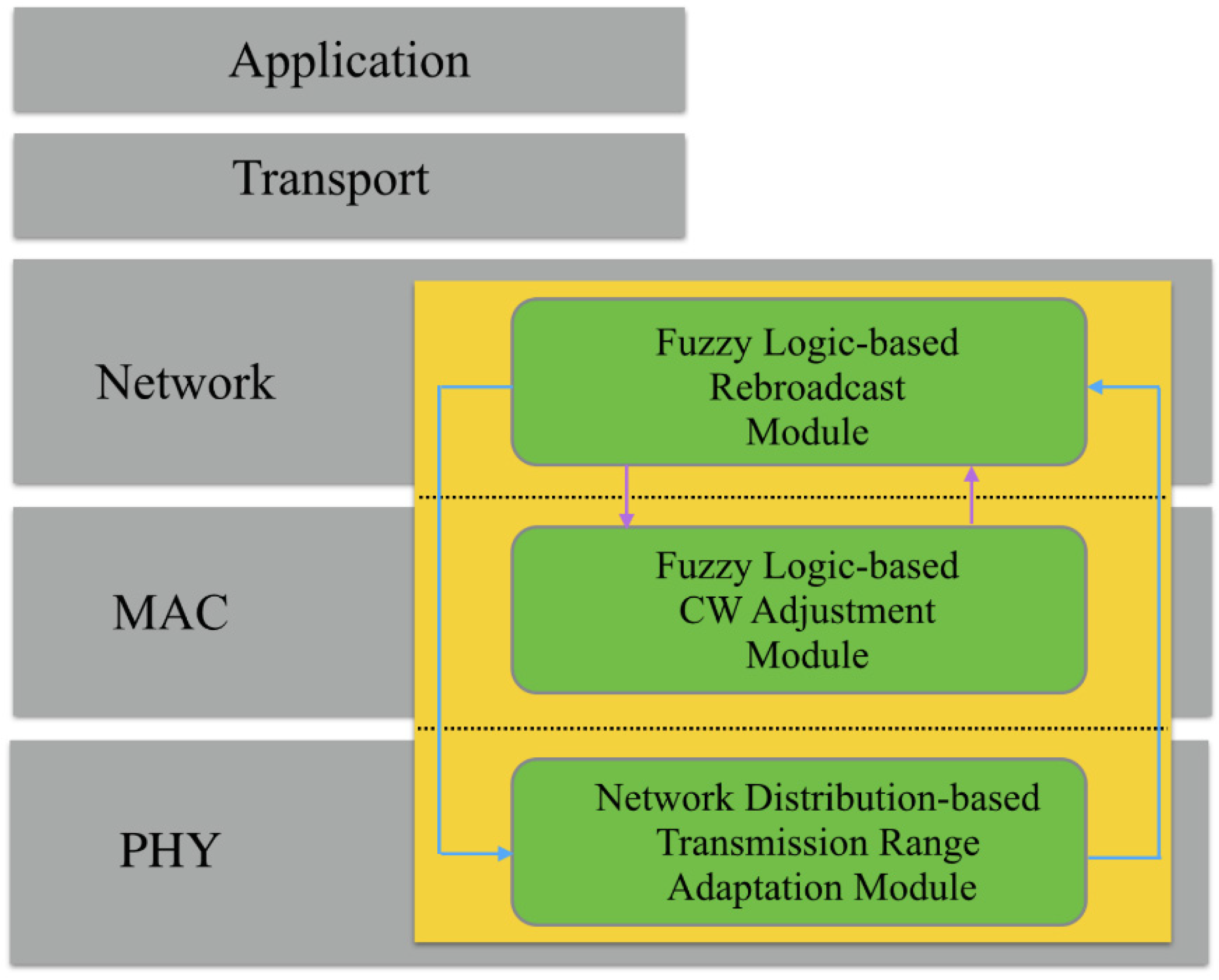
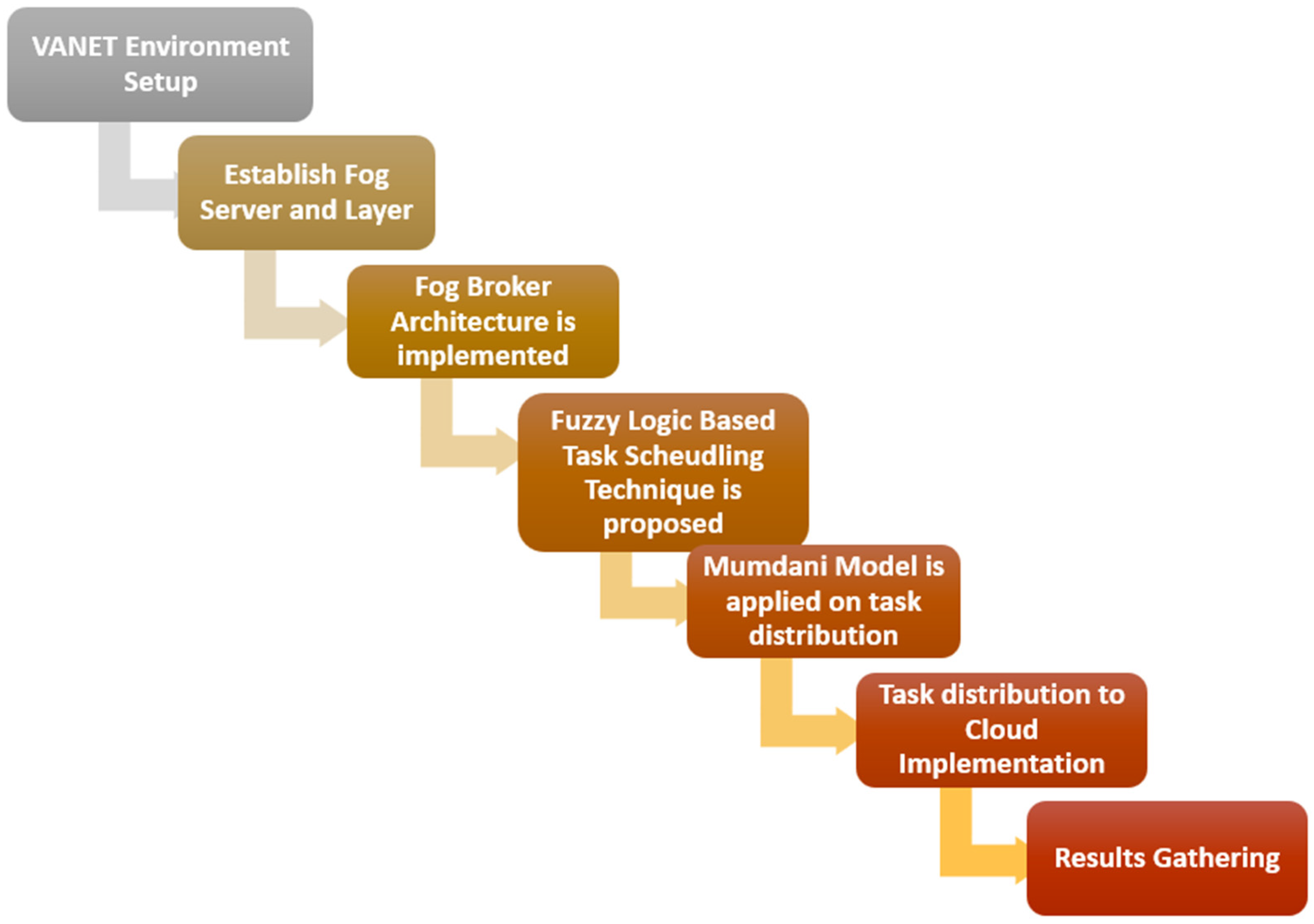



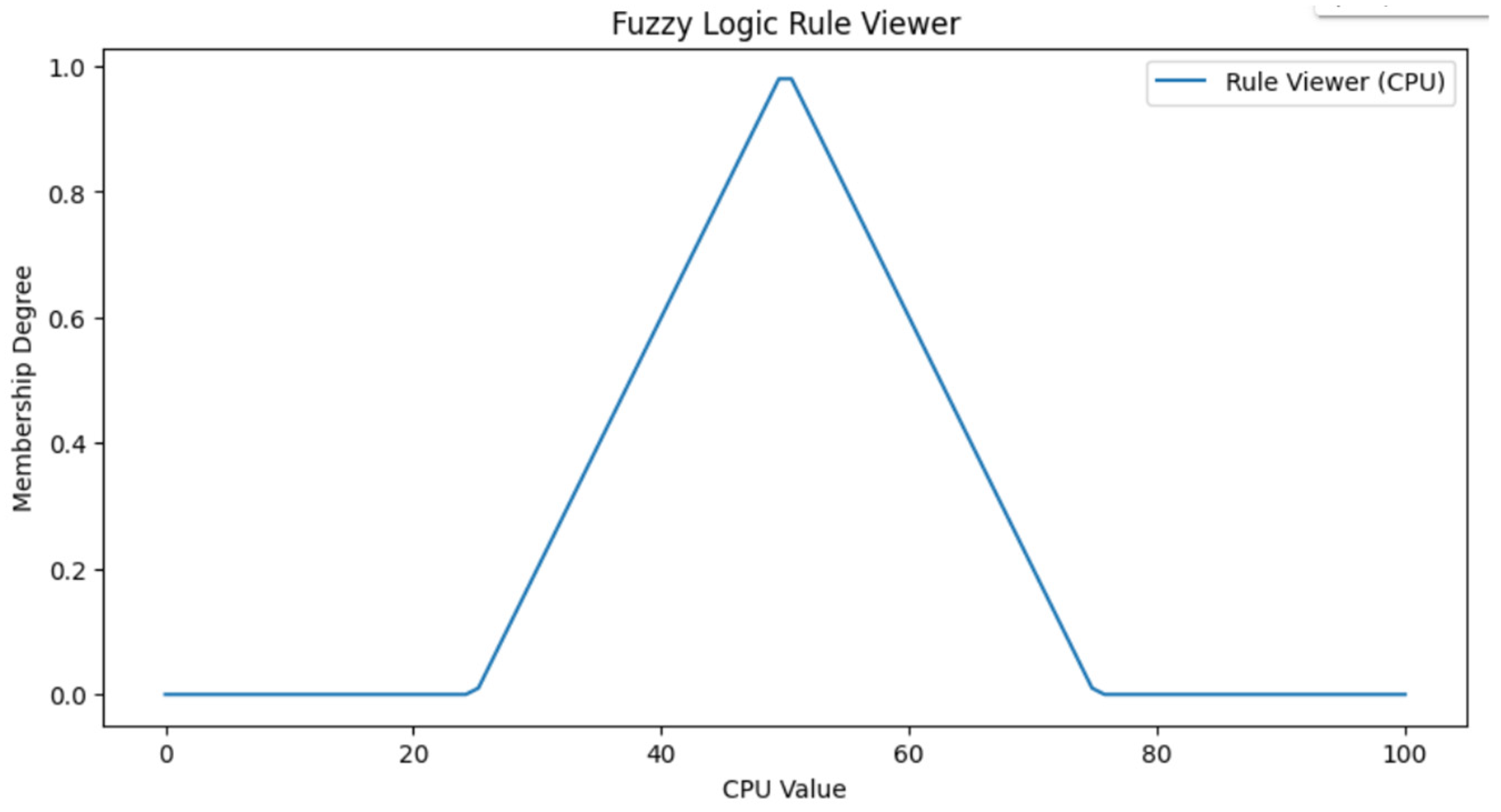


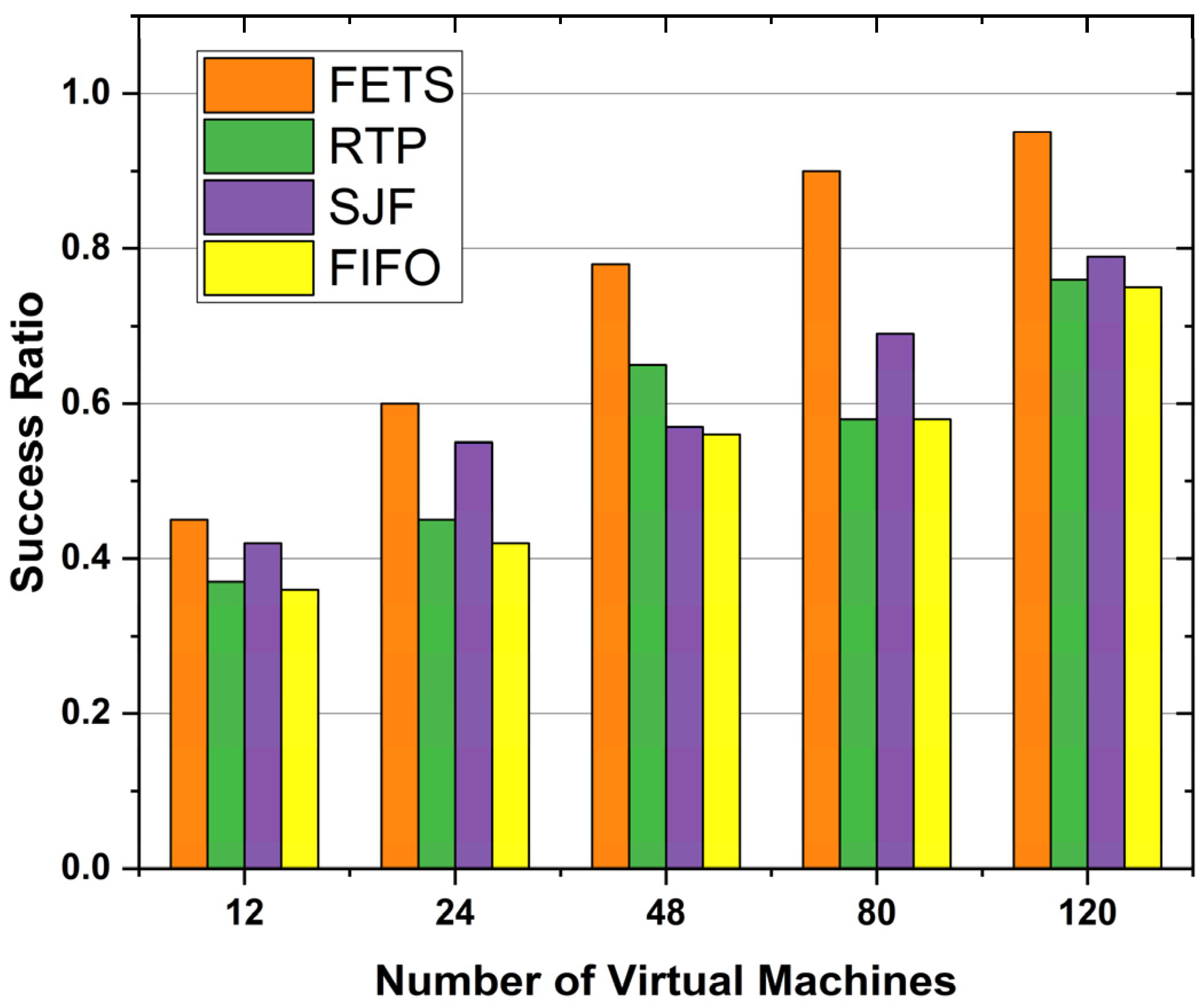

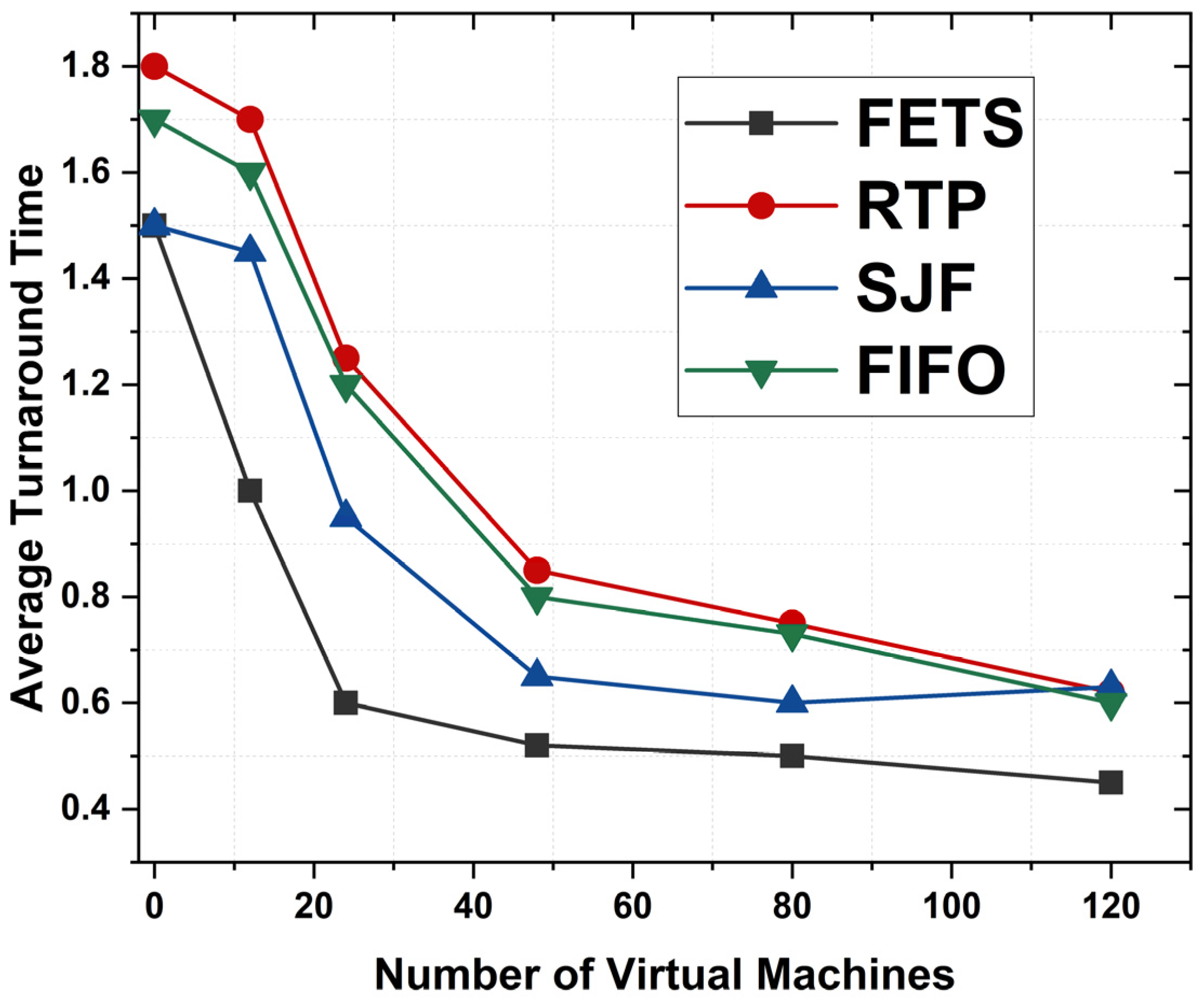
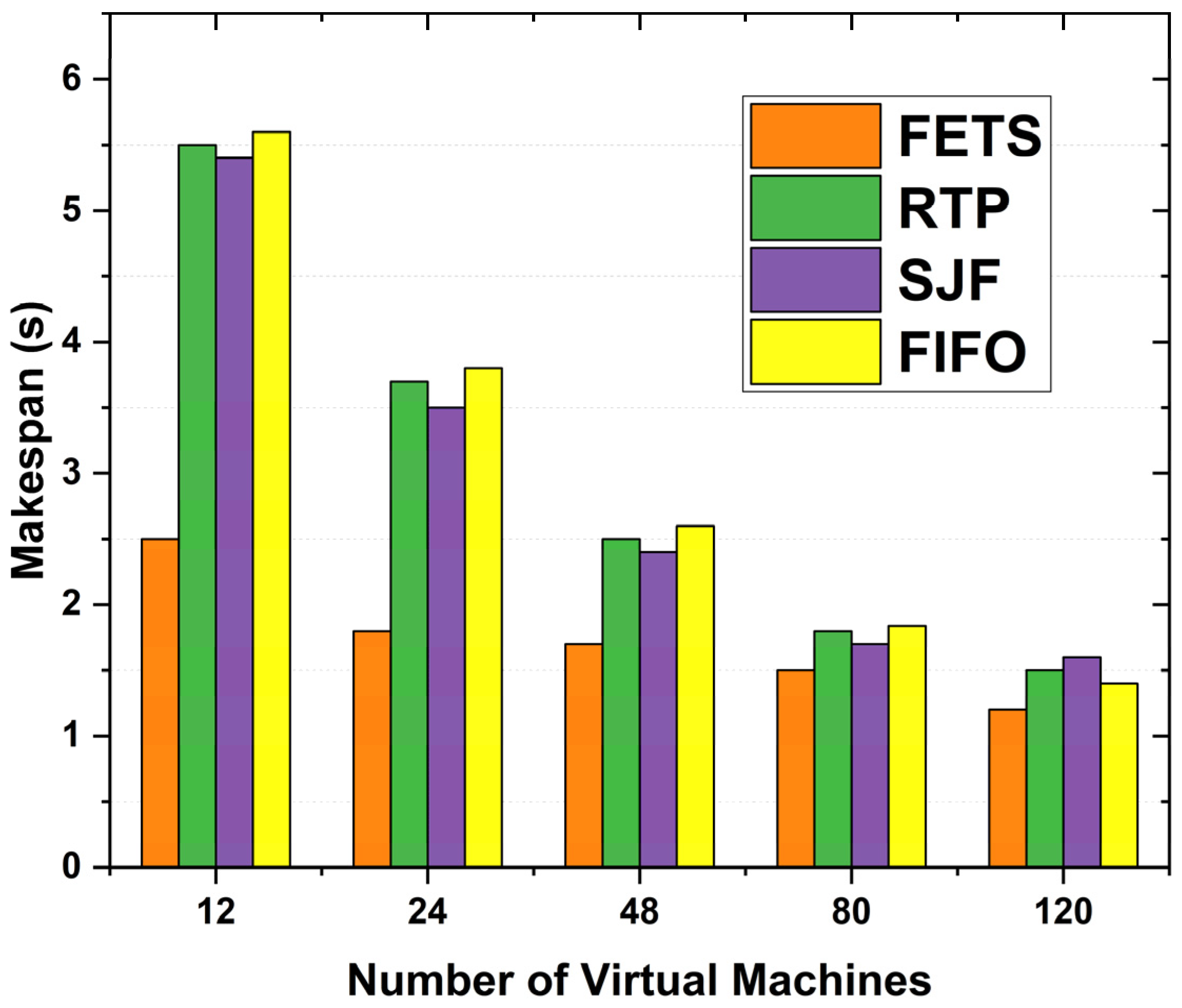

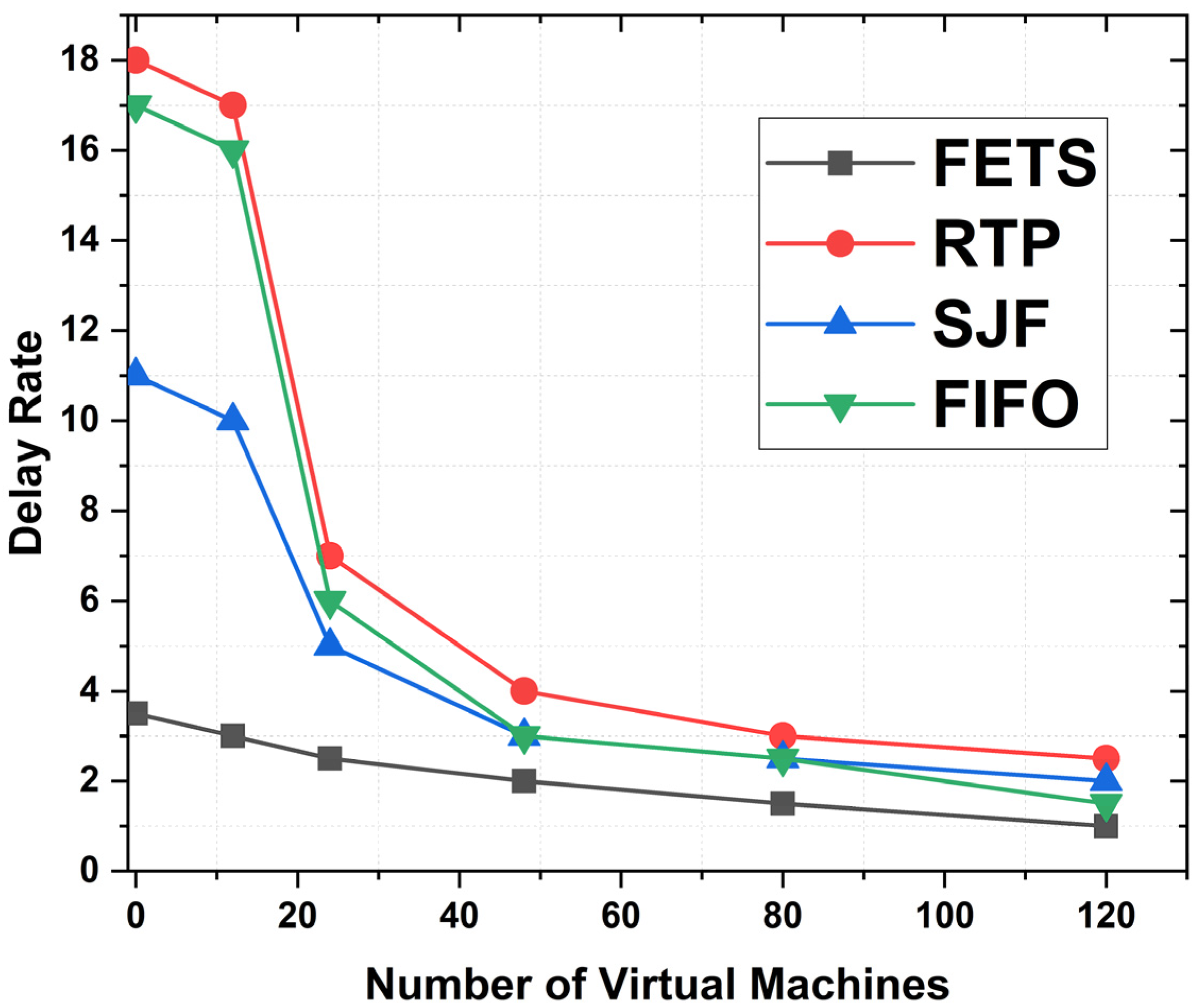

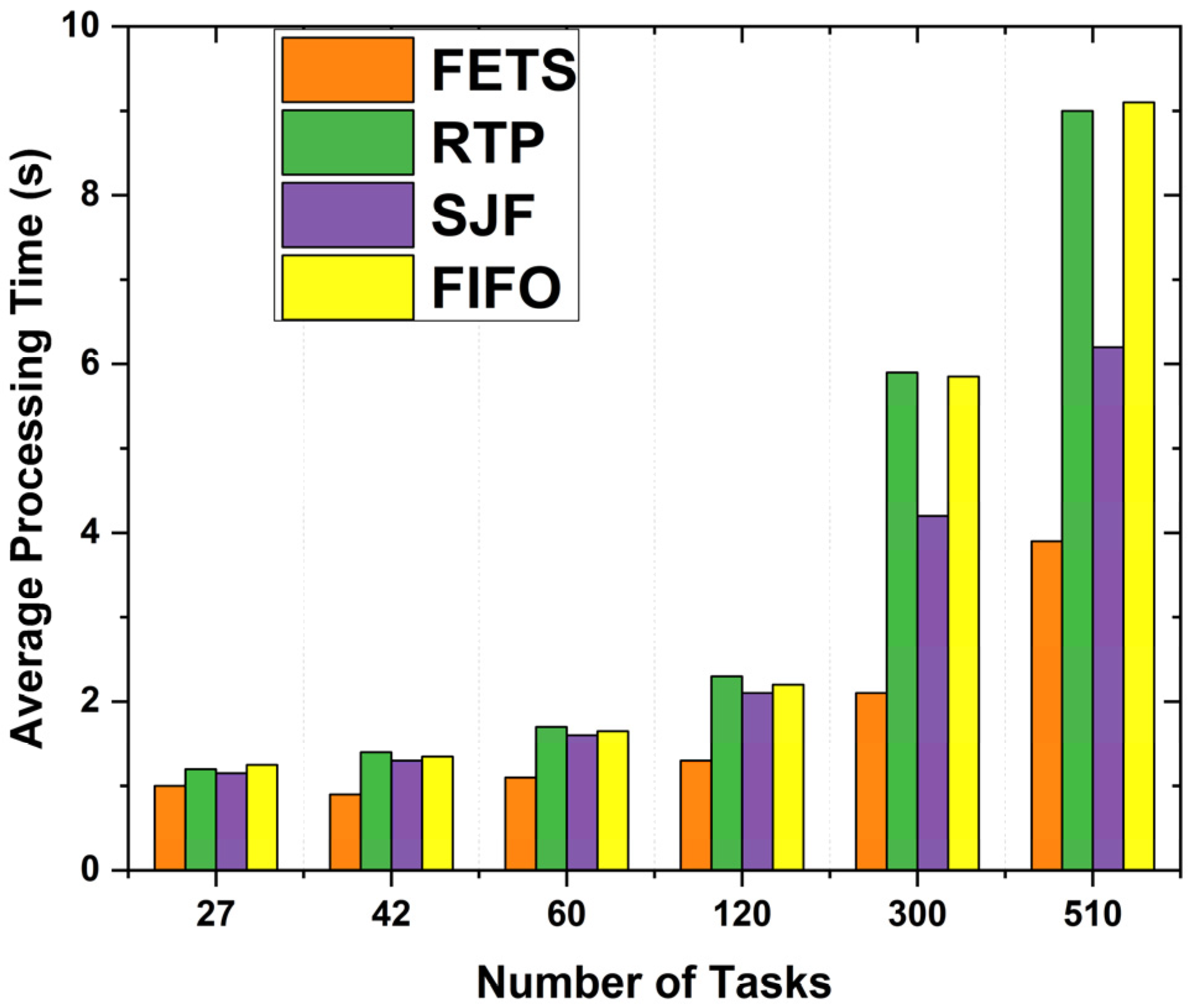

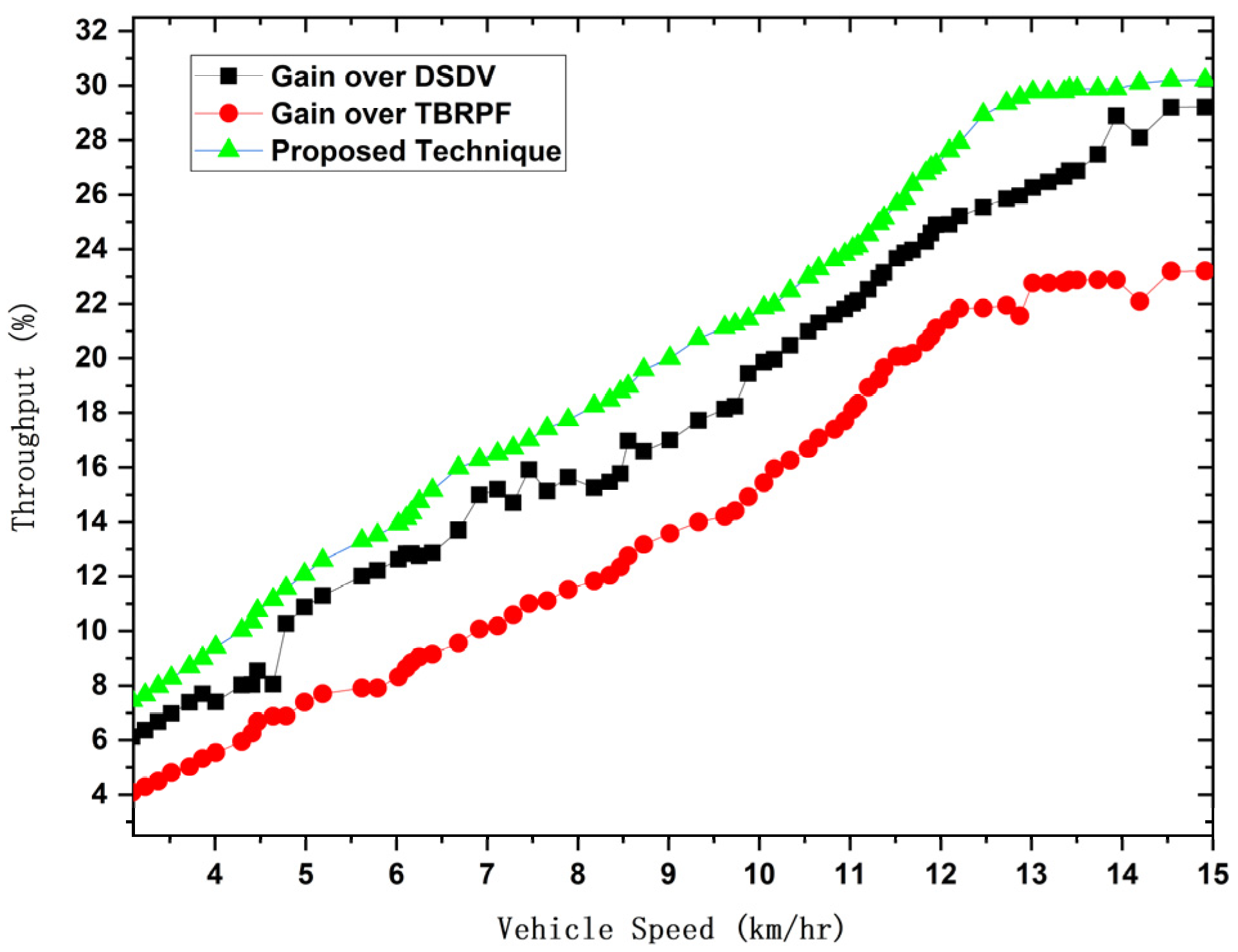
| Author and Year | Problem | Methodology | Contributions | Limitations |
|---|---|---|---|---|
| Gupta et al. (2018) [34] | Limited task scheduling efficiency in IoV | Machine learning | Proposes a novel fuzzy logic-based approach for efficient task scheduling in IoV, enhancing overall system performance. | Limited to simulation-based validation; real-world applicability requires exploration. |
| Chen and Wang (2017) [35] | Challenges in task offloading in fog computing | Optimization algorithms | Investigates task offloading challenges in fog computing, providing insights into efficient resource utilization. | It focuses on general fog computing; specific IoV considerations need further exploration. |
| Zhang et al. (2019) [36] | Bandwidth constraints in VANET | Genetic algorithms | Addresses bandwidth limitations in VANET, offering a genetic algorithm-based solution for improved data transmission. | Lacks consideration for the broader IoV ecosystem and fog-based processing. |
| Lee and Kim (2020) [37] | Latency issues in IoV | Deep learning | Examines latency issues in IoV, introducing a deep learning approach to minimize response times. | Limited discussion of task scheduling; focuses more on latency mitigation. |
| Wang et al. (2016) [38] | Resource constraints in fog computing | Heuristic approaches | Investigates resource constraints in Fog computing, proposing heuristic methods for optimal resource allocation. | Limited emphasis on fuzzy logic does not explicitly address IoV-based task scheduling. |
| Liu et al. (2018) [39] | Vehicle mobility challenges in IoV | Mathematical modeling | Explores challenges related to vehicle mobility in IoV, leveraging mathematical models for predictive analysis. | Limited discussion of task scheduling methodologies; focuses more on mobility modeling. |
| Sharma and Patel (2021) [40] | Inefficiencies in VANET processing power | Metaheuristic algorithms | Introduces metaheuristic algorithms to optimize processing power usage in VANETs. | Lacks exploration of fuzzy logic-based approaches and broader IoV context. |
| Proposed Methodology | VANET faces task scheduling challenges | Fuzzy logic-based RSU-less IoV scheduling approach | Our contribution involves introducing a fuzzy logic-based fog-enabled task scheduling technique in VANETs to enhance task time and energy efficiency. Leveraging fog and fuzzy logic, our model efficiently schedules resource-intensive tasks evaluated using Mumdani fuzzification. We designed a V2V-based fuzzy logic VANET architecture that demonstrates superior simulation performance. | Lack of implementation of machine learning techniques that can more effectively schedule the tasks. |
| CPU | Storage | Bandwidth | Latency | Task_Deadline | Task_Execution |
|---|---|---|---|---|---|
| Low | Low | Low | Low | Low | Cloud_Layer |
| Low | Low | Low | Low | Low | Fog_Layer |
| Low | Low | Low | Low | Medium | Cloud_Layer |
| Low | Low | Low | Low | Medium | Fog_Layer |
| Low | Low | Low | Low | High | Cloud_Layer |
| Low | Low | Low | Low | High | Fog_Layer |
| Low | Low | Low | Medium | Low | Cloud_Layer |
| Low | Low | Low | Medium | Low | Fog_Layer |
| Low | Low | Low | Medium | Medium | Cloud_Layer |
| Low | Low | Low | Medium | Medium | Fog_Layer |
| Low | Low | Low | Medium | High | Cloud_Layer |
| Low | Low | Low | Medium | High | Fog_Layer |
| Low | Low | Low | High | Low | Cloud_Layer |
| Low | Low | Low | High | Low | Fog_Layer |
| Low | Low | Low | High | Medium | Cloud_Layer |
| Low | Low | Low | High | Medium | Fog_Layer |
| Low | Low | Low | High | High | Cloud_Layer |
| Low | Low | Low | High | High | Fog_Layer |
| Low | Low | Medium | Low | Low | Cloud_Layer |
| Low | Low | Medium | Low | Low | Fog_Layer |
| Low | Low | Medium | Low | Medium | Cloud_Layer |
| Low | Low | Medium | Low | Medium | Fog_Layer |
| Low | Low | Medium | Low | High | Cloud_Layer |
| Low | Low | Medium | Low | High | Fog_Layer |
| Low | Low | Medium | Medium | Low | Cloud_Layer |
| Low | Low | Medium | Medium | Low | Fog_Layer |
| Low | Low | Medium | Medium | Medium | Cloud_Layer |
| Low | Low | Medium | Medium | Medium | Fog_Layer |
| Low | Low | Medium | Medium | High | Cloud_Layer |
| Low | Low | Medium | Medium | High | Fog_Layer |
| Low | Low | Medium | High | Low | Cloud_Layer |
| Low | Low | Medium | High | Low | Fog_Layer |
| Low | Low | Medium | High | Medium | Cloud_Layer |
| Low | Low | Medium | High | Medium | Fog_Layer |
| Low | Low | Medium | High | High | Cloud_Layer |
| Low | Low | Medium | High | High | Fog_Layer |
| Low | Low | High | Low | Low | Cloud_Layer |
| Low | Low | High | Low | Low | Fog_Layer |
| Low | Low | High | Low | Medium | Cloud_Layer |
| Low | Low | High | Low | Medium | Fog_Layer |
| Low | Low | High | Low | High | Cloud_Layer |
| Low | Low | High | Low | High | Fog_Layer |
| Low | Low | High | Medium | Low | Cloud_Layer |
| Low | Low | High | Medium | Low | Fog_Layer |
| Low | Low | High | Medium | Medium | Cloud_Layer |
| Low | Low | High | Medium | Medium | Fog_Layer |
| Low | Low | High | Medium | High | Cloud_Layer |
| Low | Low | High | Medium | High | Fog_Layer |
| Low | Low | High | High | Low | Cloud_Layer |
| Low | Low | High | High | Low | Fog_Layer |
| Low | Low | High | High | Medium | Cloud_Layer |
| Low | Low | High | High | Medium | Fog_Layer |
| Low | Low | High | High | High | Cloud_Layer |
| Low | Low | High | High | High | Fog_Layer |
| Low | Medium | Low | Low | Low | Cloud_Layer |
| Low | Medium | Low | Low | Low | Fog_Layer |
| Low | Medium | Low | Low | Medium | Cloud_Layer |
| Low | Medium | Low | Low | Medium | Fog_Layer |
| Low | Medium | Low | Low | High | Cloud_Layer |
| Low | Medium | Low | Low | High | Fog_Layer |
| Low | Medium | Low | Medium | Low | Cloud_Layer |
| Low | Medium | Low | Medium | Low | Fog_Layer |
| Low | Medium | Low | Medium | Medium | Cloud_Layer |
| Low | Medium | Low | Medium | Medium | Fog_Layer |
| Low | Medium | Low | Medium | High | Cloud_Layer |
| Low | Medium | Low | Medium | High | Fog_Layer |
| Low | Medium | Low | High | Low | Cloud_Layer |
| Low | Medium | Low | High | Low | Fog_Layer |
| Low | Medium | Low | High | Medium | Cloud_Layer |
| Low | Medium | Low | High | Medium | Fog_Layer |
| Low | Medium | Low | High | High | Cloud_Layer |
| Low | Medium | Low | High | High | Fog_Layer |
| Low | Medium | Medium | Low | Low | Cloud_Layer |
| Low | Medium | Medium | Low | Low | Fog_Layer |
| Low | Medium | Medium | Low | Medium | Cloud_Layer |
| Low | Medium | Medium | Low | Medium | Fog_Layer |
| Low | Medium | Medium | Low | High | Cloud_Layer |
| Low | Medium | Medium | Low | High | Fog_Layer |
| Low | Medium | Medium | Medium | Low | Cloud_Layer |
| Low | Medium | Medium | Medium | Low | Fog_Layer |
| Low | Medium | Medium | Medium | Medium | Cloud_Layer |
| Low | Medium | Medium | Medium | Medium | Fog_Layer |
| Low | Medium | Medium | Medium | High | Cloud_Layer |
| Low | Medium | Medium | Medium | High | Fog_Layer |
| Low | Medium | Medium | High | Low | Cloud_Layer |
| Low | Medium | Medium | High | Low | Fog_Layer |
| Low | Medium | Medium | High | Medium | Cloud_Layer |
| Low | Medium | Medium | High | Medium | Fog_Layer |
| Low | Medium | Medium | High | High | Cloud_Layer |
| Low | Medium | Medium | High | High | Fog_Layer |
| Low | Medium | High | Low | Low | Cloud_Layer |
| Low | Medium | High | Low | Low | Fog_Layer |
| Low | Medium | High | Low | Medium | Cloud_Layer |
| Low | Medium | High | Low | Medium | Fog_Layer |
| Low | Medium | High | Low | High | Cloud_Layer |
| Low | Medium | High | Low | High | Fog_Layer |
| Low | Medium | High | Medium | Low | Cloud_Layer |
| Low | Medium | High | Medium | Low | Fog_Layer |
| Low | Medium | High | Medium | Medium | Cloud_Layer |
| Low | Medium | High | Medium | Medium | Fog_Layer |
| Low | Medium | High | Medium | High | Cloud_Layer |
| Low | Medium | High | Medium | High | Fog_Layer |
| Low | Medium | High | High | Low | Cloud_Layer |
| Low | Medium | High | High | Low | Fog_Layer |
| Low | Medium | High | High | Medium | Cloud_Layer |
| Low | Medium | High | High | Medium | Fog_Layer |
| Low | Medium | High | High | High | Cloud_Layer |
| Low | Medium | High | High | High | Fog_Layer |
| Low | High | Low | Low | Low | Cloud_Layer |
| Low | High | Low | Low | Low | Fog_Layer |
| Low | High | Low | Low | Medium | Cloud_Layer |
| Low | High | Low | Low | Medium | Fog_Layer |
| Low | High | Low | Low | High | Cloud_Layer |
| Low | High | Low | Low | High | Fog_Layer |
| Low | High | Low | Medium | Low | Cloud_Layer |
| Low | High | Low | Medium | Low | Fog_Layer |
| Low | High | Low | Medium | Medium | Cloud_Layer |
| Low | High | Low | Medium | Medium | Fog_Layer |
| Low | High | Low | Medium | High | Cloud_Layer |
| Low | High | Low | Medium | High | Fog_Layer |
| Low | High | Low | High | Low | Cloud_Layer |
| Low | High | Low | High | Low | Fog_Layer |
| Low | High | Low | High | Medium | Cloud_Layer |
| Low | High | Low | High | Medium | Fog_Layer |
| Low | High | Low | High | High | Cloud_Layer |
| Low | High | Low | High | High | Fog_Layer |
| Low | High | Medium | Low | Low | Cloud_Layer |
| Low | High | Medium | Low | Low | Fog_Layer |
| Low | High | Medium | Low | Medium | Cloud_Layer |
| Low | High | Medium | Low | Medium | Fog_Layer |
| Low | High | Medium | Low | High | Cloud_Layer |
| Low | High | Medium | Low | High | Fog_Layer |
| Low | High | Medium | Medium | Low | Cloud_Layer |
| Low | High | Medium | Medium | Low | Fog_Layer |
| Low | High | Medium | Medium | Medium | Cloud_Layer |
| Low | High | Medium | Medium | Medium | Fog_Layer |
| Low | High | Medium | Medium | High | Cloud_Layer |
| Input/Output Variables | Fuzzy Sets |
|---|---|
| Task execution | Cloud layer, fog layer |
| Latency | Low, medium, and high |
| Deadline of task | Low, medium, and high |
| Storage | Low, medium, and high |
| CPU | Low, medium, and high |
| Bandwidth | Low, medium, and high |
| S.No. | Notation | Description |
|---|---|---|
| 1 | Virtual machines are used in fog computing to process the scheduled task. | |
| 2 | Utilized bandwidth of the proposed system | |
| 3 | The total time each task is processed on the fog VM | |
| 4 | An ID is associated with each of the tasks. | |
| 5 | The vehicular node | |
| 6 | Obtain total GPS coordinates for the final version of the system. | |
| 7 | Hop count | The number of intermediate nodes passed from the system to another system |
| 8 | The ID associated with each identifier | |
| 9 | The lower limit threshold is set for the waiting time of the scheduled task. | |
| 10 | Time is required to process the task toward the final delivered values. | |
| 11 | Drop the packet before schedule because the threshold limit is exceeded. | |
| 12 | Set of all VMs in the fog layer of the proposed model | |
| 13 | Unique identifier for the VM | |
| 14 | Total time for task submission toward processing | |
| 15 | Network latency for the proposed system | |
| 16 | Bandwidth associated with fog layer | |
| 17 | Fog network | |
| 18 | Fog cloud-based identifier | |
| 19 | Fuzzy logic-based decision algorithm | |
| 20 | Decision logic | |
| 21 | Scheduled task uploaded toward the fog cloud |
| Process Type | CPU (Mips) | Storage (Gigabyte) | Memory (Megabyte) | Bandwidth Mbps |
|---|---|---|---|---|
| Cloud | 42,700 | 1,000,000 | 40,000 | 10,000 |
| Fog | 20,600 | 10,000 | 10,000 | 100,000 |
| VM (Computational) | 1400 | 1000 | 1500 | 1000 |
| VM (Storage) | 900 | 1500 | 1000 | 1000 |
| VM (Bandwidth) | 1000 | 1000 | 1000 | 1500 |
| VM (Standard) | 1500 | 1500 | 1500 | 1500 |
Disclaimer/Publisher’s Note: The statements, opinions and data contained in all publications are solely those of the individual author(s) and contributor(s) and not of MDPI and/or the editor(s). MDPI and/or the editor(s) disclaim responsibility for any injury to people or property resulting from any ideas, methods, instructions or products referred to in the content. |
© 2024 by the authors. Licensee MDPI, Basel, Switzerland. This article is an open access article distributed under the terms and conditions of the Creative Commons Attribution (CC BY) license (https://creativecommons.org/licenses/by/4.0/).
Share and Cite
Ehtisham, M.; Hassan, M.u.; Al-Awady, A.A.; Ali, A.; Junaid, M.; Khan, J.; Abdelrahman Ali, Y.A.; Akram, M. Internet of Vehicles (IoV)-Based Task Scheduling Approach Using Fuzzy Logic Technique in Fog Computing Enables Vehicular Ad Hoc Network (VANET). Sensors 2024, 24, 874. https://doi.org/10.3390/s24030874
Ehtisham M, Hassan Mu, Al-Awady AA, Ali A, Junaid M, Khan J, Abdelrahman Ali YA, Akram M. Internet of Vehicles (IoV)-Based Task Scheduling Approach Using Fuzzy Logic Technique in Fog Computing Enables Vehicular Ad Hoc Network (VANET). Sensors. 2024; 24(3):874. https://doi.org/10.3390/s24030874
Chicago/Turabian StyleEhtisham, Muhammad, Mahmood ul Hassan, Amin A. Al-Awady, Abid Ali, Muhammad Junaid, Jahangir Khan, Yahya Ali Abdelrahman Ali, and Muhammad Akram. 2024. "Internet of Vehicles (IoV)-Based Task Scheduling Approach Using Fuzzy Logic Technique in Fog Computing Enables Vehicular Ad Hoc Network (VANET)" Sensors 24, no. 3: 874. https://doi.org/10.3390/s24030874
APA StyleEhtisham, M., Hassan, M. u., Al-Awady, A. A., Ali, A., Junaid, M., Khan, J., Abdelrahman Ali, Y. A., & Akram, M. (2024). Internet of Vehicles (IoV)-Based Task Scheduling Approach Using Fuzzy Logic Technique in Fog Computing Enables Vehicular Ad Hoc Network (VANET). Sensors, 24(3), 874. https://doi.org/10.3390/s24030874






